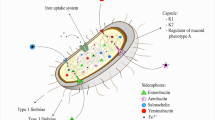Summary
Of 13 consecutive episodes of gram-negative septicemia (Escherichia coli eight,Klebsiella oxytoca four,Klebsiella pneumoniae one) among 113 infants in three specialcare neonatal units studied, five episodes were epidemiologically related according to a novel fingerprinting method for enterobacteria. In ten episodes the invasive phenotype was found in the fecal flora of up to 54% of the fellow infants in the same ward and for periods of up to 70 days. Two units exchanged patients, which further promoted the transmission of invasive strains. The attack index was highest for certainE. coli strains, generally low forK. oxytoca strains, but lowest for otherE. coli strains. The infants contracting septicemia had lower birth weight (p=0.04) or were more often classified as high-risk infants than matched non-infected fecal carriers of the invasive strains (p=0.04). In summary, gram-negative neonatal septicemia was either due to an apparently high-virulent strain capable of attacking the single full-term infant carrier or a high-colonizing phenotype of lower apparent virulence, which occasionally attacked a high-risk infant among a large number of infants colonized.
Zusammenfassung
Von 13 aufeinanderfolgenden Episoden gramnegativer Septikämie (achtEscherichia coli, vierKlebsiella oxytoca, eineKlebsiella pneumoniae), die bei 113 Kindern von drei Neugeborenen-Intensivstationen auftraten, wurden fünf nach neuen Fingerprint-Methoden für Enterobakterien als epidemiologisch assoziiert erkannt. In zehn Episoden fand sich bis zu 70 Tage lang der invasive Phänotyp in der Stuhlflora von bis zu 54% der gleichzeitig behandelten Kinder derselben Station. Zwei Stationen hatten Patienten ausgetauscht, was die Verbreitung der invasiven Stämme weiter begünstigte. Der Fallindex war für bestimmteE. coli-Stämme am höchsten, fürK. oxytoca im allgemeinen gering und bei anderenE. coli-Stämmen am niedrigsten. Kinder, die eine Septikämie entwickelten, hatten ein niedrigeres Geburtsgewicht (p=0,04) oder wurden häufiger als Hockrisikokinder eingestuft als Vergleichskinder, die den invasiven Stamm im Stuhl hatten aber nicht infiziert waren (p=0,04). Die gramnegative Neugeborenensepsis war folglich entweder auf einen hochvirulenten Stamm zurückzuführen, der fähig war, ein reifes, besiedeltes Neugeborenes zu befallen oder einen hochgradig kolonisierenden Phänotyp eines Stammes mit geringerer offensichtlicher Virulenz, der gelegentlich ein Hochrisikokind unter einer großen Zahl kolonisierter Kinder befiel.
Similar content being viewed by others
References
Goldmann, D. A., Freeman, J., Durbin, W. A. Jr. Nosocomial infection and death in neonatal intensive care unit. J. Inf. Dis. 147 (1983) 635–641.
Bonadio, W. A. Klebsiella pneumoniae bacteremia in children. Fifty-seven cases in 10 years. AJDC 143 (1989) 1061–1063.
Denny, F., St. John, M. A., Lewis, D. B., Daniel, B. NosocomialKlebsiella pneumoniae colonization in a neonatal special care unit. Annuals Tropical Paediatrics 6 (1986) 123–126.
Tullus, K., Olsson-Liljequist, B., Lundström. G., Burman, L. G. Antibiotic susceptibility of 629 bacterial blood and CSF isolates from Swedish infants and the therapeutic implications. Acta Paediatr. Scand 80 (1991) 205–212.
Eriksson, M., Melén, B., Myrbäck, K-E., Windbladh, B., Zetterström, R. Bacterial colonization of newborn infants in a neonatal intensive care unit. Acta Paediatr. Scand. 71 (1982) 779–783.
Hill, H. R., Hunt, C. E., Matsen, J. M. Nosocomial colonization withKlebsiella, type 26, in a neonatal intensive-care unit associated with an outbreak of sepsis, meningitis, and necrotizing enterocolitis. J. Pediatr. 85 (1974) 415–419.
Selden, R., Lee, S., Wang, W. L. L., Bennett, J. V., Eickhoff, T. C. Nosocomial Klebsiella infections: intestinal colonization as a reservoir. Ann. Intern. Med. 74 (1971) 657–664.
Hurley, R., De Louvois, J. Bloodstream infections and perinatal morbidity. J. Clin. Pathol. 34 (1981) 271–276.
Aronsson, B., Eriksson, M., Herin, P., Rylander, M. Gentamicin-resistantKlebsiella spp. andEscherichia coli in a neonatal intensive care unit. Scand. J. Infect. Dis. 23 (1991) 195–199.
Fryklund, B., Tullus, K., Berglund, B., Burman, L. G. Importance of environment and the faecal flora of infants, nursing staff and parents as sources of gram-negative bacteria colonizing newborns in three neonatal wards. Infection 20 (1992) 253–257.
Fryklund, B., Tullus, K., Burman, L. G. Epidemiology of enteric bacteria in neonatal units — influence of procedures and patient variables. J. Hosp. Infect. 18 (1991) 15–21.
Carlsson, B., Gothefors, L., Ahlstedt, S., Hanson, L. A., Winberg, J. Studies ofEscherichia coli O antigen specific antibodies in human milk, maternal serum and cord blood. Acta Paediatr. Scand 65 (1976) 216–224.
Kühn, I. Biochemical fingerprinting ofE. coli: a simple method for epidemiological investigations. J. Microbiol. Methods 3 (1985) 159–170.
Kühn, I., Burman, L. G., Eriksson, L., Möllby, R. Subtyping ofKlebsiella by biochemical fingerprinting: a simple system for epidemiological investigations. J. Microbiol. Methods 2 (1990) 177–185.
Tullus, K., Berglund, B., Fryklund, B., Kühn, I., Burman, L. G. Epidemiology of faecal strains of the familyEnterobacteriaceae in 22 neonatal units and influence of antibiotic policy. J. Clin. Microbiol. 26 (1988) 1166–1170.
Kühn, I., Tullus, K., Burman, L. G. The use of the PhP-KE biochemical fingerprinting system in epidemiological studies of faecalEnterobacter cloacae strains from infants in Swedish neonatal wards. Epidemiol. Infect. 107 (1991) 311–319.
Tullus, K., Brauner, A., Fryklund, B., Munkhammar, T., Rabsch, W., Reissbrodt, R., Burman, L. G. Host factors versus virulence-associated bacterial characteristics in neonatal and infantile bacteraemia and meningitis caused byEscherichia coli. J. Med. Microbiol. 36 (1992) 203–208.
Klein, B. S., Perloff, W. H., Maki, D. G. Reduction of nosocomial infection during pediatric intensive care by protective isolation. N. Engl. J. Med. 320 (1989) 1714–1721.
Bettelheim, K. A., Teoh-Chan, C. H., Chandler, M. E., O'Farrell, S. M., Rahamin, L., Shaw, E. J., Shooter, R. A. Spread ofEscherichia coli colonizing newborn babies and their mothers. J. Hyg. (Cambridge) 73 (1974) 383–387.
Author information
Authors and Affiliations
Rights and permissions
About this article
Cite this article
Fryklund, B., Burman, L.G. & Tullus, K. Epidemiology and attack index of gram-negative bacteria causing invasive infection in three special-care neonatal units and risk factors for infection. Infection 23, 76–80 (1995). https://doi.org/10.1007/BF01833869
Received:
Accepted:
Issue Date:
DOI: https://doi.org/10.1007/BF01833869




